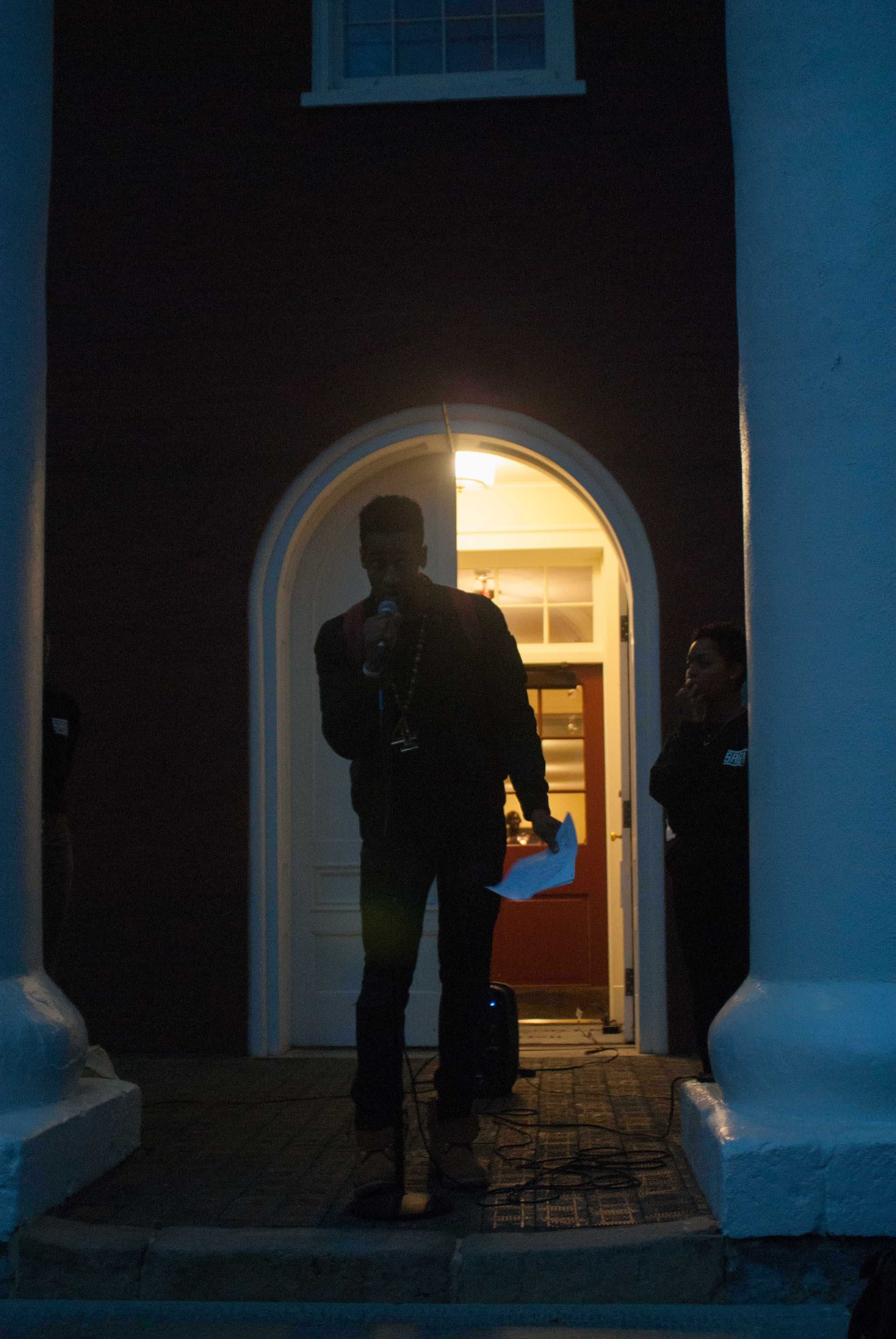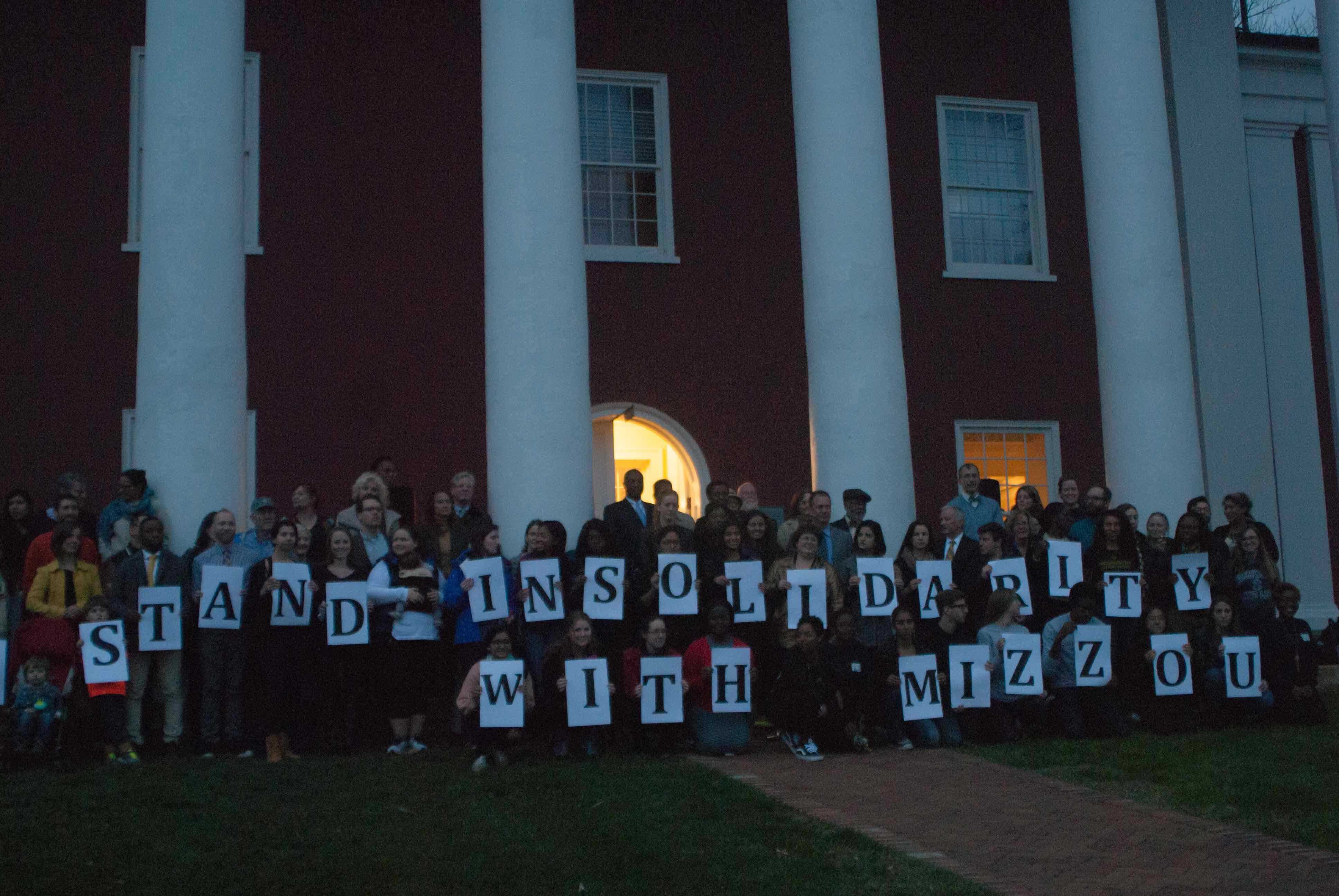Students, faculty gather to support Mizzou
November 19, 2015
As dusk fell on the Colonnade Wednesday evening, MaKayla Lorick, ’19, was poised between two columns, a microphone in front of her.
“During my first few weeks [at Washington and Lee], I felt on edge. I remember a student coming up to me, sniffing my hair, and telling me that it smelled weird. And, to justify this, he said whenever something was different, it was weird,” Lorick said.
Dozens of students and faculty gathered on Washington & Lee’s Colonnade in support of protests that originated at the University of Missouri as early as September. There, Mizzou students, and subsequently students on other college campuses, have raised concerns about incidences of racism.
These incidents, Lorick said, present an opportunity for W&L students to talk about the experience of black students at their own university.
“It is no secret at Washington and Lee that African-Americans, both students and faculty, are extremely small in number,” she said. “Having said this, while attending a predominately white institution named after two former slave-owners, we find that it is imperative for black students find security, presence and a sense of space here.”
Ijezie Ikwuezunma, ’16, stood before the crowd as it grew to about 100 people, though nearly half left before the end of the rally. Ikwuezunma called for students and faculty to “take care of our own home [sic] before we set out to place any judgment on another institution.”
“In the absence of black students and faculty, yet the preponderance of statements like, ‘Do you play a sport here?’ or ‘You’re only here because of affirmative action,’ I find myself doubting whether or not I’m worthy to attend this university, and even in questioning my own position within this community,” Ikwuezunma said.

Ijezie Ikwuezunma speaks to the crowd in front of Washington Hall
Ikwuezunma also spoke about W&L’s history and the oppression it entails.
“This institution prides itself on its southern tradition and values,” he said. “Well, if you flip back through the pages of history, one will undoubtedly find that although this university was built off the back-breaking sweat and tears by men and women that look like me, it most certainly was not built for men and women that look like me.”
Professor Deborah Miranda, who identifies as Native American, was the final speaker of the night.
Sharing a story about her first days as a W&L professor, Miranda recalled an incident in which she, an African-American professor and a Chinese-American professor, were stopped at a Dean’s lunch for new faculty and told by a staff member, “I’m sorry, this luncheon is only for faculty.”
Miranda said students should make their voices heard and should urge for a more diverse faculty.
“Go and speak to the administrators—write them emails, talk to them about how you feel about not seeing yourself represented in the professors that are here at Washington and Lee,” she said.
Miranda ended the night by celebrating the courage of those who spoke.
“I am in complete admiration for the students who are here and the students who have spoken up,” she said. “That takes a tremendous amount of courage, I want to tell you, it took me this whole evening to get up the courage to come up and talk to you.”
W&L’s President Kenneth Ruscio was also in attendance.
“I admire and respect the students for bringing this together,” he said. “I think it will advance Washington and Lee in the future.”

Concerned Alumnus • Dec 21, 2015 at 1:19 pm
Did the students of African descent fail to realize that Washington & Lee University is named for President George Washington and General Robert E. Lee prior to applying and matriculating? Did the students of African descent not realize that the majority of Washington & Lee students and faculty represent the majority culture of the United States of America?
As a matter of fact, General Robert E. Lee freed his slaves (which he never purchased — they were inherited through his father-in-law) in 1862. They were freed several years before the war was over and considerably earlier than those enslaved his Northern counterparts. For example, General Sherman freed his slaves in 1865. Since the victors write history, these sorts of facts are not widely disseminated.
Perhaps the students of African descent will work to abolish Affirmative Action so that future students will never have to be asked whether they attend Washington & Lee or any other college or university because of racial preference. If students of African descent want to prove to doubters that they are as qualified as all other students on campus, demand that the University publish the aggregate high school GPA, class rank and SAT/ACT score for those of European descent, those of Asian descent and those of African descent.
Ms. Miranda “identifies” as Native American. What does that mean? Can anyone “identify” as anything without “being” something?
Below is a quote from the article:
“This institution prides itself on its southern tradition and values,” he said. “Well, if you flip back through the pages of history, one will undoubtedly find that although this university was built off the back-breaking sweat and tears by men and women that look like me, it most certainly was not built for men and women that look like me.”
Is it a fact that men and women of African descent “built” Washington & Lee or is this merely an incendiary but baseless assertion? And, if they assisted in the construction, were they enslaved or free? It is implied that the University was constructed solely by slave labor under the harsh eye of vicious overseers gripping long leather whips (“back-breaking sweat and tears of men women who look like me”). Perhaps this student is unaware that a man of African descent, John Chavis, attended Washington & Lee (Washington Academy) in the late 1700s and went on to be a Presbyterian minister.
I need a safe space.